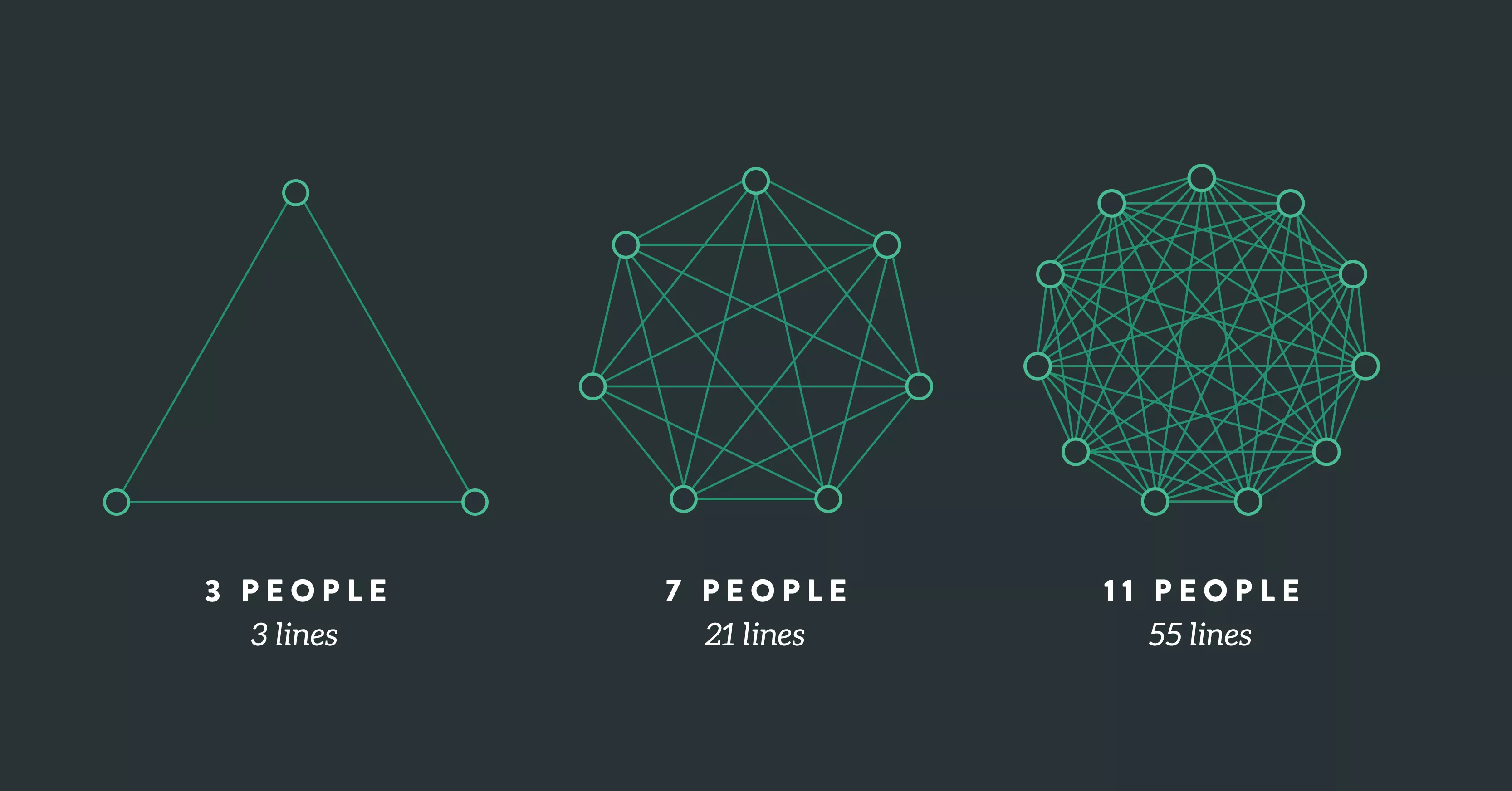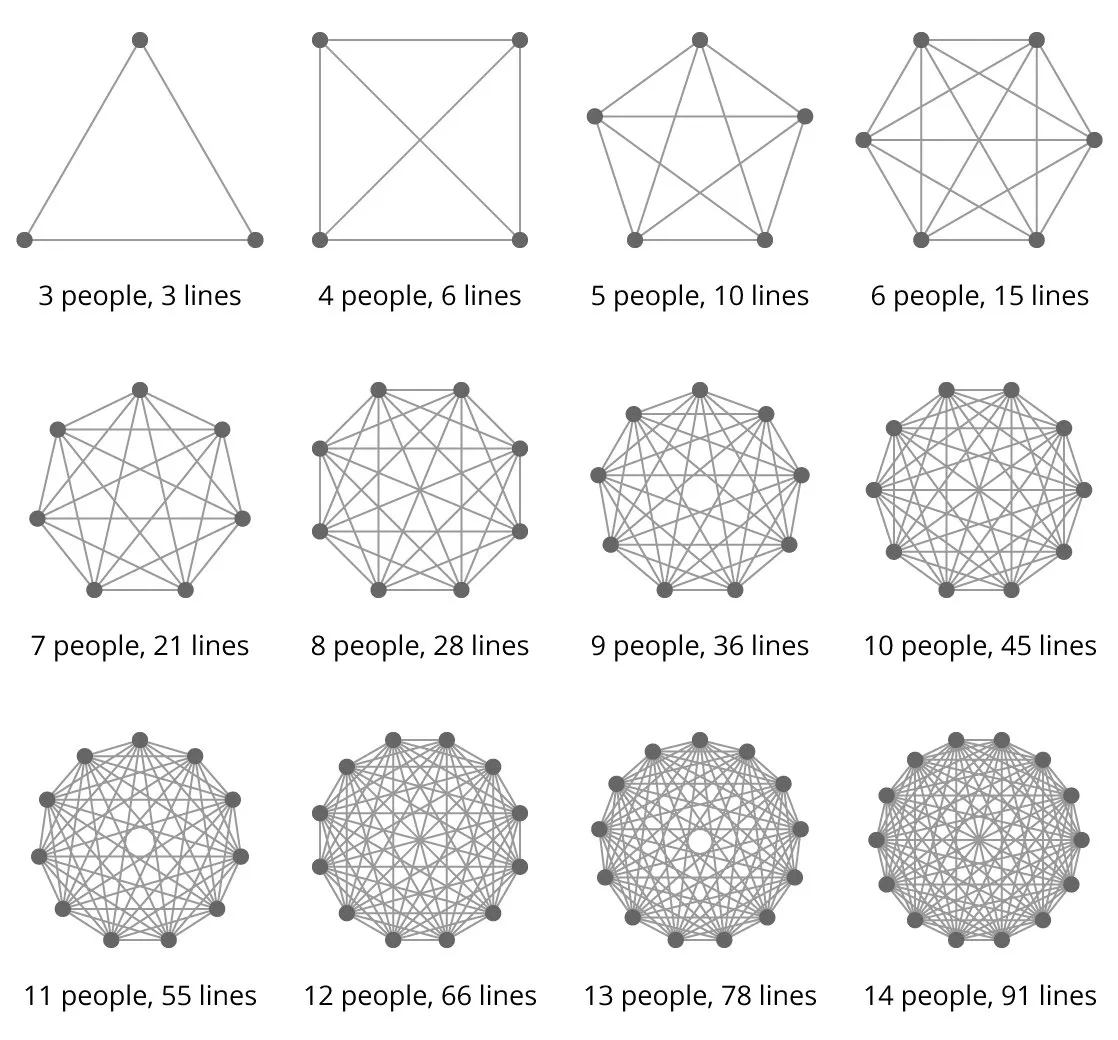Lines Of Communication and Team Size: Applying Brooks’ Law

In a Field Notes post from 2014, LeadingAgile consultant Andrew Fuqua considers Brooks’ Law in the context of the Theory of Constraints. Brooks’ Law is the adage that adding manpower to a late software project makes it later. Fuqua notes that Brooks observed people “and months are interchangeable commodities only when a task can be partitioned among many workers with no lines of communication among them.”
Effective lines of communication is key to any project. When collaborative methods are used, like the methods guided by Agile principles, the level of communication among workers is higher than with traditional methods.
Teams using traditional methods generally have a hierarchical structure. Lines of communication tend to be vertical, between the manager or team lead and the team members. Horizontal communication occurs between individual team members when they need to ask each other for help, but on the whole the team depends on indirect communication (such as documents) for the majority of routine communication.
Teams using collaborative methods generally have a peer structure. Documents are used to capture historical information and for static data. The dynamic lines of communication necessary to develop the product is primarily direct, and all team members interact with all other team members throughout the day.
Lines of Communication and Team Size
In the last few years, people have been paying a lot of attention to this aspect of team effectiveness. A Google search for the phrase, lines of communication and team size yields about 412 million results. Here’s one illustration (source: Lighthouse):

Most teams in large enterprises have between 10 and 20 members. Even at the low end of that scale, a team has so many lines of communication that progress is bound to be slow.
Lines Of Communication: Predictably Irrational Management
Although Brooks wrote The Mythical Man-Month decades ago and managers have understood this principle for many years, the default response when a team falls behind schedule is to add more people. Why?
Dan Ariely explains why people make seemingly irrational decisions in his popular book, Predictably Irrational: The Hidden Forces that Shape Our Decisions. The phenomenon is familiar to those in the IT field. It’s captured in the old saying, “No one has ever been fired for choosing IBM.”
A manager won’t be fired for adding personnel to a late project. It gives the appearance of “doing something.” If the project crashes and burns, the manager can safely state that he/she did “everything possible” to save it, even to the extent of shifting funding and people from other initiatives, even in their lines of communication.
Applying Brooks’ Law
Way back in aught-and-six, give or take a season, I was the team lead for a software development project. We were an XP team of eight people. We were falling behind schedule.
My manager kindly explained the consequences of not meeting the date. He asked me how many more people I needed.
I suggested we remove two people from the team. He was surprised. He asked if some of the team members weren’t pulling their weight. Was that the reason we were falling behind?
I explained that everyone on the team was doing fine. The problem wasn’t that anyone wasn’t pulling their weight. The problem was the communication overhead on the team.
As the illustration shows, a team of eight people has 28 lines of communication. A team of six people has 15 lines of communication. Less overhead.
My manager was skeptical. He told me if the idea didn’t work, then it was all on me. His warning was not as scary as he may have intended it, because I understood Brooks’ Law and (apparently) he didn’t. I knew he was familiar with the book, but evidently he didn’t believe it.
With a team of six instead of eight, we picked up the pace of delivery without any strain and we were on track to complete the backlog within two iterations.
Line Of Communication: Corporate Madness
If an individual manager is predictably irrational, then what happens when you have hundreds of managers, thousands of projects, and tens of thousands of technical workers? Predictably: Utter madness.
Every large IT organization I have seen so far in my career has had large project teams that spend almost all their time engaged in lines of communication overhead of one sort or another. It is no exaggeration to say it takes weeks for such a team to complete a few minutes’ worth of real work.
The typical response to slow progress is to add more and more people to the teams. Just recently, a client whose teams were already too large to get very much work done were falling behind schedule. Management urgently requested approval to bring contractors on board to speed things up. Now the teams have even less time to do real work, as they have to help their new colleagues learn the system and the procedures.
There’s no chance the teams will meet their due dates. But no worries: The managers won’t be punished. After all, they’ve done “everything possible” to catch up.
Conclusion
Brooks’ Law is real. Be unpredictably rational: Use it.

Comments (3)
Larry Maccherone
Great topic and post! Two thoughts:
1. When I talk about this subject, I tend to use the phrase “cost of coordination”. Over the years, every major step forward in software engineering has been the result of a huge reduction in the cost of coordination. PCs allowed developers to work on their own without scheduling the mainframe. Source code management enabled more people to work on the same codebase. Git flow, then GitHub flow (very different) further lowered the cost by enabling independent evolution. Automated testing can be thought of as a cost of coordination reducer. DevOps is the next step on this path. So, my point is that reducing team size is only one way to lower the cost of coordination. If you can make the cost of the individual lines in your diagrams so low, it matters less how many there are. Yes, a 10-person team has 14x the lines of a 3-person team. But 14 times close to nothing is still not much.
2. When you lower the average team size, you increase the number of teams. Inter-team coordination can be much more expensive per line than intra-team coordination. In my research, the number one predictor of whether work is going to take longer than expected is amount of cross team coordination. There are a lot of factors that effect this but architecture and time-zone spans are two huge factors. The decision to lower team size is not made in a vacuum. You must make a tradeoff between inter-team vs. intra-team cost of coordination.
Tobias Mayer
I just found this article while searching for “lines of communication”. Loved it, and then saw who the author was. Good to read you again, Dave. Thank you for this. It’s perfect for what I was seeking—the diagrams and the evidence—but also offers more insights, and references one of my favourite books/essays. I’ll be offering this as suggested reading for my scrum workshop participants. Cheers!
Tobias Mayer
Re: “When you lower the average team size, you increase the number of teams”
Not necessarily. Just moving people around like this is unlikely to offer benefit, either to the organisation or the people. The aim would be to reduce the size of the team AND the number of teams. I remember reading some years ago that most development shops had about 20% highly productive people, 20% unproductive people, and 60% average producers. There is a noticeable difference between the highly productive and the average, and a less noticeable difference between the average and the unproductive, so companies would be wise to reduce their workforce by the full 80% to get the most productivity—that is, reduce by 80% and begin to rebuild. At the time, in my particular context I could not help but agree. Bloated software teams build bloated software products, slim teams build slim products. Conway’s law.